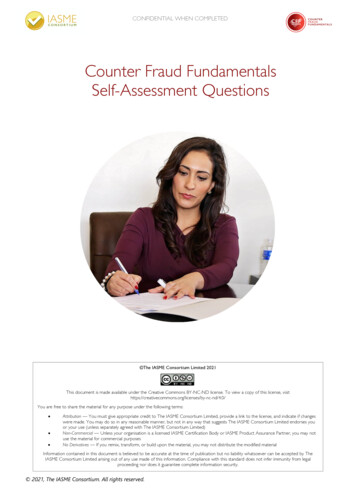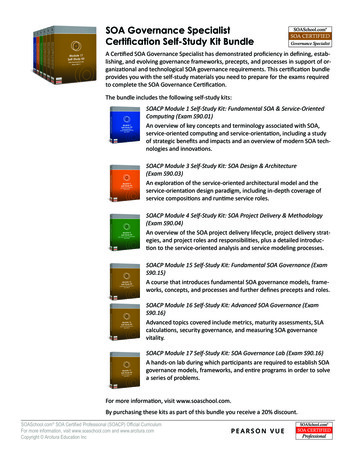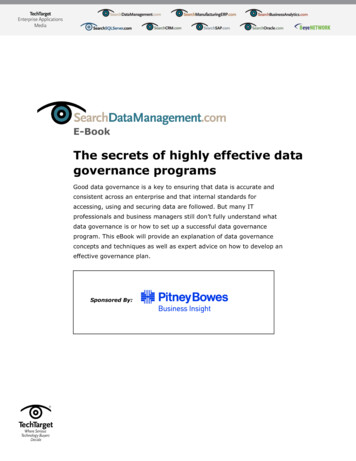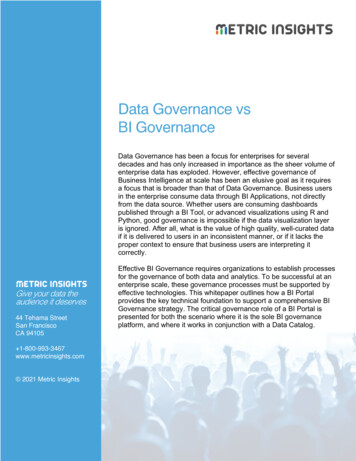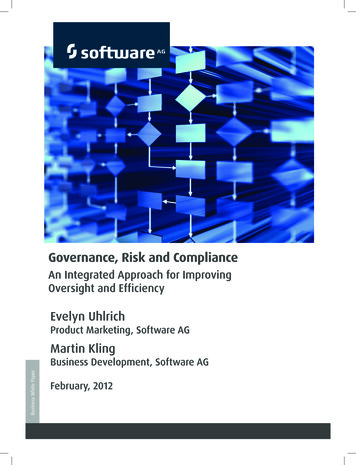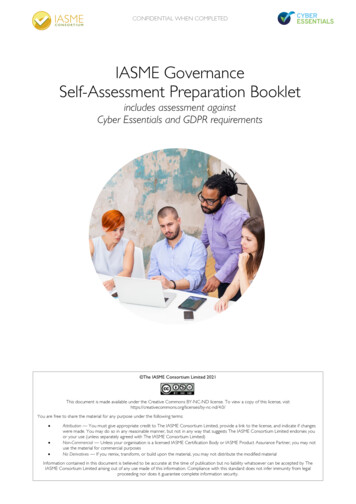
Transcription
CONFIDENTIAL WHEN COMPLETEDIASME GovernanceSelf-Assessment Preparation Bookletincludes assessment againstCyber Essentials and GDPR requirements The IASME Consortium Limited 2021This document is made available under the Creative Commons BY-NC-ND license. To view a copy of this license, /4.0/You are free to share the material for any purpose under the following terms: Attribution — You must give appropriate credit to The IASME Consortium Limited, provide a link to the license, and indicate if changeswere made. You may do so in any reasonable manner, but not in any way that suggests The IASME Consortium Limited endorses youor your use (unless separately agreed with The IASME Consortium Limited)Non-Commercial — Unless your organisation is a licensed IASME Certification Body or IASME Product Assurance Partner, you may notuse the material for commercial purposesNo Derivatives — If you remix, transform, or build upon the material, you may not distribute the modified materialInformation contained in this document is believed to be accurate at the time of publication but no liability whatsoever can be accepted by TheIASME Consortium Limited arising out of any use made of this information. Compliance with this standard does not infer immunity from legalproceeding nor does it guarantee complete information security.
CONFIDENTIAL WHEN COMPLETEDCyber Essentials Version Evendine & IASME Governance Version 11dApril 2022IntroductionThis booklet contains the question set for the IASME Governance information assurance standard:IASME GovernanceBased on international best practice, IASME Governance is risk based and includes key aspects of securitysuch as incident response, staff training, planning and operations.IASME Governance incorporates Cyber Essentials assessment and an assessment against the General DataProtection Regulation (GDPR).More information about the IAMSE Governance standard can be found athttps://www.iasme.co.ukThe IASME Governance standard incorporates the Cyber Essentials question set. If you achieve certification toIASME Governance you will also be awarded certification to Cyber Essentials.Cyber EssentialsCyber Essentials is a government-backed scheme focussing on five important technical security controls.Further guidance on the Cyber Essentials scheme can be found athttps://www.cyberessentials.ncsc.gov.ukAnswering the questionsThe booklet is intended to help you to understand the questions and take notes on the current setup in yourorganisation.In order to complete assessment, you must enter your answers via IASME’s online assessment platform. Questions which apply only to the IASME Governance standard are in redQuestions which apply to the Cyber Essentials requirements are in black.In order to achieve IASME Governance certification, most companies will need to answer the black, and redquestions.Your answers must be approved by a Board level representative, business owner or the equivalent, otherwisecertification cannot be awarded.Need help?If you need help with understanding the questions, get in contact with IASME on 44 (0)3300 882752 or emailinfo@iasme.co.uk. Alternatively, IASME has a network of Certification Bodies who are skilled informationassurance companies who can provide advice on the standards and who can help you make changes to yoursetup in order to achieve compliance. Visit the IASME website at www.iasme.co.uk to find you nearestCertification Body.4
CONFIDENTIAL WHEN COMPLETEDYour CompanyIn this section we need to know a little about how your organisation is set up so we can ask you themost appropriate questions.A1.1. What is your organisation's name (for companies: as registered with Companies House)?Please provide the full registered name for the company being certified. If you are certifying the local entity of amultinational company, provide the name of the local entity as per Companies House registration.Certification should cover one organisation; there are occasions when a certificate can be issued to more than onecompany. This will be determined by the IT infrastructure. An example would be where all the companies within acompany group share the same IT infrastructure.If a client requires certification for a company that has more than one subsidiary registered with CompaniesHouse under different names and registration numbers, as long as they share the same network boundary, theycan all be entered within one certificate.For example: The Stationery Group, incorporating subsidiaries, The Paper Mill and The Pen House.Adding a trading name to the certification: If an organisation operates under a different trading name to theregistered company name, this may also be entered. For example: registered company trading as Company Y.The answer provided to A1.1 will be used to generate the CE certificate.[Notes]A1.2. What type of organisation are you?“LTD” – Limited Company (Ltd or PLC)“LLP” – Limited Liability Partnership (LLP)“CIC” – Community Interest Company (CIC)“COP” – Cooperative“MTL” – Other Registered Mutual (Community Benefit Society, Credit Union, Building Society, Friendly Society)“CHA” – Registered Charity“GOV” – Government Agency or Public Body“SOL” – Sole Trader“PRT” – Other Partnership“SOC” – Other Club/ Society“OTH” – Other Organisation[Notes]A1.3. What is your organisation's registration number (if you have one)?If you are a UK limited company, your registration number will be provided by Companies House, in the Republicof Ireland, this will be provided by Companies Registration Office. Charities, partnerships, and other organisationsshould provide their registration number if applicable.If a client is applying for certification for more than one registered company, just one registration number can beentered to represent the entire group.[Notes]5
CONFIDENTIAL WHEN COMPLETEDA1.4. What is your organisation's address (for companies: as registered with Companies House)?Please provide the legal registered address for your organisation, if different from the main operating location.[Notes]A1.5. What is your main business?Please summarise the main occupation of your organisation.Academia - Pre SchoolsDefenceAcademia - Primary SchoolsDiplomacyAcademia - Secondary Schools Emergency ServicesAcademia - AcademiesEnergy - ElectricityAcademia - CollegesEnergy - GasAcademia - UniversitiesEnergy - OilAerospaceEngineeringAgriculture, Forestry iesHer Majesty's GovernmentChemicals(HMG)Civil NuclearHealthConstructionHospitality - FoodConsultancyHospitality - AccommodationHospitality - HotelsITIntelligenceLaw Enforcement (Serious &Organised Crime)LegalLeisureManaged Services - IT ManagedServicesManaged Services - OtherManaged ServicesManufacturingMediaMembership OrganisationsMiningOther (please describe)PharmaceuticalsPoliticalPostal ServicesPropertyR&DRetailTelecomsTransport - AviationTransport - MaritimeTransport - RailTransport - RoadWaste ManagementWaterOverseas[Notes]A1.6. What is your website address?Please provide your website address (if you have one). This can be a Facebook/LinkedIn page if you prefer.[Notes]A1.7. How many staff are home workers?Any employee contracted or legally required to work at home for any period of time at the time of theassessment, needs to be classed as working from home for Cyber Essentials.[Notes]6
CONFIDENTIAL WHEN COMPLETEDA1.8. Is this application a renewal of an existing certification or is it the first time you have applied forcertification?The Cyber Essentials certification requires annual renewal. If you have previously achieved Cyber Essentials,please select "Renewal". If you have not previously achieved Cyber Essentials, please select "First TimeApplication".[Notes]A1.9. What is your main reason for applying for certification?Please let us know the main reason why you are applying for certification. If there are multiple reasons, pleaseselect the one that is most important to you. This helps us to understand how people are using our certifications.(If your reason for certifying is for a government contract, please provide the contract or framework name. Thisinformation is helpful to us, but you are not required to provide it).[Notes]A1.10. Have you read the 'Cyber Essentials Requirements for IT Infrastructure' document?Document is available on the NCSC Cyber Essentials website and should be read before completing this questionset. uirements-for-IT-infrastructure-3-0.pdf[Notes]7
CONFIDENTIAL WHEN COMPLETEDScope of AssessmentIn this section, we need you to describe the elements of your organisation which you want to certifyto this accreditation. The scope should be either the whole organisation or an organisational subunit (for example, the UK operation of a multinational company). All computers, laptops, servers,mobile phones, tablets, and firewalls/routers that can access the internet and are used by thisorganisation or sub-unit to access organisational data or services should be considered "in-scope".All locations that are owned or operated by this organisation or sub-unit, whether in the UK orinternationally should be considered “in-scope”. A scope that does not include user devices is notacceptable.The scoping requirements have been updated to include cloud services. More information can befound in the ‘Cyber Essentials requirement for Infrastructure v3.0’ document. Link is referenced inquestion A1.10.A2.1.Does the scope of this assessment cover your whole organisation? Please note: Your organisationis only eligible for free cyber insurance if your assessment covers your whole company. If you answer"No" to this question you will not be invited to apply for insurance.Your whole organisation would include all divisions and all people and devices that use business data.[Notes]A2.2. If it is not the whole organisation, then what scope description would you like to appear on yourcertificate and website?Your scope description should provide details of any areas of your business that have internet access and havebeen excluded from the assessment (for example, "whole organisation excluding development network").[Notes]A2.3. Please describe the geographical locations of your business which are in the scope of thisassessment.You should provide either a broad description (i.e., All UK offices) or simply list the locations in scope (i.e.,Manchester and Glasgow retail stores).[Notes]8
CONFIDENTIAL WHEN COMPLETEDA2.4. Please list the quantities of laptops, desktops and virtual desktops within the scope of thisassessment. You must include model and operating system version for all devices. For Windowsdevices the Edition and Feature version are also required. All devices that are connecting to cloudservices must be included.Please provide a summary of all laptops, computers and virtual desktops that are used for accessingorganisational data or services and have access to the internet (for example, “We have 25 DELL Vostro 5515laptops running Windows 10 Professional version 20H2 and 10 MacBook Air laptops running MacOS Big Sur").This applies to both corporate and personal owned devices (BYOD). You do not need to provide serial numbers,mac addresses or further technical information.A scope that does not include end user devices is not acceptable.[Notes]A2.4.1 Please list the quantity of Thin Clients within scope of this assessment. Please include make,model and operating systems.This question is currently for Information only. From January 2023 this question will require that your thin clients aresupported and receiving security updates and will be marked for compliance. thin clients are currently in scope for allother controls.Please provide a summary of all the thin clients in scope that are connecting to the organisational data forservices. (Definitions of which are in the ‘CE Requirements for Infrastructure document’ located A2.5. Please list the quantity of servers, virtual servers and virtual server hosts (hypervisor). You mustinclude the operating system.Please list the quantity of all servers within scope of this assessment. For example: 2 x VMware ESXI 6.7 hosting 8virtual windows 2016 servers; 1 x MS Server 2019; 1 x Redhat Enterprise Linux 8.3.[Notes]A2.6. Please list the quantities of tablets and mobile devices within the scope of this assessment. Youmust include model and operating system versions for all devices. All devices that are connectingto cloud services must be included.All tablets and mobile devices that are used for accessing organisational data or services and have access to theinternet must be included in the scope of the assessment. This applies to both corporate and personal owneddevices (BYOD). You do not need to provide serial numbers, mac addresses or other technical information. Alltablets and mobile devices connecting to cloud services cannot be excluded from the scope of certification.A scope that does not include end user devices is not acceptable.[Notes]9
CONFIDENTIAL WHEN COMPLETEDA2.7. Please provide a list of the networks that will be in the scope for this assessment.You should include details of each network used in your organisation including its name, location, and its purpose(i.e., Main Network at Head Office for administrative use, Development Network at Malvern Office for testingsoftware, (home workers network - based in UK). You do not need to provide IP addresses or other technicalinformation.You should also summarise any home-workers and include their internet boundary that will be taken intoconsideration for the assessment.For further guidance see the Home Working section in the 'CE Requirements for Infrastructure Notes]A2.8. Please provide a list of network equipment that will be in scope for this assessment (includingfirewalls and routers). You must include make and model of each device listed.You should include all equipment that controls the flow of data such as routers and firewalls. You do not need toinclude switches or wireless access points that do not contain a firewall or do not route internet traffic. You do notneed to provide IP addresses, MAC addresses or serial numbers.[Notes]A2.9. Please list all cloud services that are provided by a third party and used by your organisation.You need to include details of all your cloud services. This includes all types of services – IaaS, PaaS, and SaaS.Definitions of the different types of cloud services are provided in the ‘CE Requirements for InfrastructureDocument’. uirements-for-IT-infrastructure-3-0.pdfPlease note cloud services cannot be excluded from the scope of CE.[Notes]A2.10. Please provide the name and role of the person who is responsible for managing the informationsystems in the scope of this assessment?This should be the person who influences and makes decisions about the computers, laptops, servers, tablets,mobile phones, and network equipment within your organisation. This person must be a member of yourorganisation and cannot be a person employed by your outsourced IT provider.[Notes]10
CONFIDENTIAL WHEN COMPLETEDInsuranceAll organisations with a head office domiciled in the UK and a turnover of less than 20 million getautomatic cyber insurance if they achieve Cyber Essentials certification. The insurance is free ofcharge, but you can opt out of the insurance element if you choose. This will not change the price ofthe assessment package. If you want the insurance, then we do need to ask some additional questionsand these answers will be forwarded to the broker. The answers to these questions will not affect theresult of your Cyber Essentials assessment. It is important that the insurance information provided isas accurate as possible and that the assessment declaration is signed by a senior person at Board levelor equivalent, to avoid any delays to the insurance policy being issued.A3.1. Is your head office domiciled in the UK and is your gross annual turnover less than 20m?This question relates to the eligibility of your organisation for the included cyber insurance.[Notes]A3.2. If you have answered “yes” to the last question, then your organisation is eligible for the includedcyber insurance if you gain certification. If you do not want this insurance element, please opt outhere.There is no additional cost for the insurance. You can see more about it at y-insurance/[Notes]A3.3. What is your total gross revenue? Please provide figure to the nearest 100K. You only need toanswer this question if you are taking the insurance.The answer to this question will be passed to the insurance broker in association with the cyber insurance you willreceive at certification. Please be as accurate as possible - figure should be to the nearest 100K.[Notes]A3.4. What is the organisation email contact for the insurance documents? You only need to answerthis question if you are taking the insurance.The answer to this question will be passed to the insurance broker in association with the cyber insurance you willreceive at certification, and they will use this to contact you with your insurance documents and renewalinformation.[Notes]11
CONFIDENTIAL WHEN COMPLETEDBoundary Firewalls and Internet GatewaysFirewall is the generic name for a software(host-based) or hardware device which provides technicalprotection between your networks and devices and the Internet, referred to in the question set asboundary firewalls. Your organisation will have a physical, virtual or software firewall at the internetboundary. Software firewalls are also included within all major operating system for Laptops, Desktopsand Servers. Firewalls are powerful physical, virtual or software devices, which need to be configuredcorrectly to provide effective security.Questions in this section applies to: Boundary Firewalls, Routers, Computers, Laptops and Servers,IaaS.A4.1. Do you have firewalls at the boundaries between your organisation’s internal networks, laptops,desktops, servers, and the internet?You must have firewalls in place between your office network and the internet.[Notes]A4.1.1 When corporate or user-owned devices (BYOD) are not connected to the organisation’sinternal network, how are the firewall controls applied?You should also have firewalls in place for home-based workers, if those users are not using a corporate VirtualPrivate Network (VPN) connected to your office network, they will need to rely on the software firewall includedin the operating system of the device in use.[Notes]A4.2. When you first receive an internet router or hardware firewall device it will have had a defaultpassword on it. Has this initial password been changed on all such devices?The default password must be changed on all routers and firewalls, including those that come with a uniquepassword pre-configured (i.e. BT Business Hub, Draytek Vigor 2865ac).[Notes]A4.2.1 Please describe the process for changing the firewall password.You need to be aware of how the password on the firewall is changed. Please give brief description of how this isachieved.[Notes]12
CONFIDENTIAL WHEN COMPLETEDA4.3. Is the new firewall password configured to meet the Password-based authenticationrequirements? Please select the option being usedA. Multi-factor authentication, with a minimum password length of 8 characters and no max length.B. Automatic Blocking of common passwords, with minimum password length of 8 characters andno maximum length.C. A password minimum length of 12 characters and no maximum length.Acceptable technical controls that you can use to manage the quality of your passwords are outlined in the newsection about Password-based authentication in the ‘Cyber Essentials Requirements for IT Infrastructure’document. . Do you change the firewall password when you know or suspect it has been compromised?Passwords may be compromised if there has been a virus on your system or if the manufacturer notifies you of asecurity weakness in their product. You should be aware of this and know how to change the password if thisoccurs. When relying on software firewalls on end user devices the password to access the device will need to bechanged.[Notes]A4.5. Do you have any services enabled that can be accessed externally from your internet router,hardware firewall or software firewall?At times your firewall may be configured to allow a system on the inside to become accessible from the internet(for example: a VPN server, a mail server, an FTP server, or a service that is accessed by your customers). This issometimes referred to as "opening a port". You need to show a business case for doing this because it can presentsecurity risks. If you have not enabled any services, answer "No". By default, most firewalls block all services.[Notes]A4.5.1 Do you have a documented business case for all of these services?The business case should be documented and recorded. A business case must be signed off at board level andassociated risks reviewed regularly.[Notes]13
CONFIDENTIAL WHEN COMPLETEDA4.6. If you do have services enabled on your firewall, do you have a process to ensure they aredisabled in a timely manner when they are no longer required? A description of the process isrequired.If you no longer need a service to be enabled on your firewall, you must remove it to reduce the risk ofcompromise. You should have a process that you follow to do this (i.e., when are services reviewed, who decidesto remove the services, who checks that it has been done).[Notes]A4.7. Have you configured your boundary firewalls so that they block all other services from beingadvertised to the internet?By default, most firewalls block all services from inside the network from being accessed from the internet, butyou need to check your firewall settings.[Notes]A4.8. Are your boundary firewalls configured to allow access to their configuration settings over theinternet?Sometimes organisations configure their firewall to allow other people (such as an IT support company) to changethe settings via the internet. If you have not set up your firewalls to be accessible to people outside yourorganisations or your device configuration settings are only accessible via a VPN connection, then answer "no" tothis question.[Notes]A4.9. If yes, is there a documented business requirement for this access?You must have made a decision in the business that you need to provide external access to your routers andfirewalls. This decision must be documented (i.e., written down).[Notes]A4.10. If yes, is the access to the settings protected by either multi-factor authentication or by onlyallowing trusted IP addresses combined with managed authentication to access the settings?Please explain which option is used.If you allow direct access to configuration settings via your router or firewall's external interface, this must beprotected by one of the two options.[Notes]14
CONFIDENTIAL WHEN COMPLETEDA4.11. Do you have software firewalls enabled on all of your desktop computers, laptops and servers?Your software firewall must be configured and enabled at all times, even when sitting behind a physical/virtualboundary firewall in an office location. You can check this setting on Macs in the Security & Privacy section ofSystem Preferences. On Windows laptops you can check this by going to Settings and searching for "Windowsfirewall". On Linux try "ufw status".[Notes]A4.12. If no, is this because software firewalls are not installed by default for the operating system youare using? Please list the operating systems.Only very few operating systems do not have software firewalls available. Examples might include embeddedLinux systems or bespoke servers. For the avoidance of doubt, all versions of Windows, macOS and all commonLinux distributions such as Ubuntu do have software firewalls available.[Notes]15
CONFIDENTIAL WHEN COMPLETEDSecure ConfigurationComputers and Cloud Services are often not secure upon default installation or setup. An ‘out-of-thebox’ set-up can often include an administrative account with a standard, publicly known defaultpassword, one or more unnecessary user accounts enabled (sometimes with special access privileges )and pre-installed but unnecessary applications or services. All of these present security risks.Questions in this section apply to: Servers, Desktop Computers, Laptops, Thin Clients, Tablets,Mobile Phones, IaaS, PaaS, and SaaS.A5.1. Where you are able to do so, have you removed or disabled all the software and services thatyou do not use on your laptops, desktop computers, thin clients, servers, tablets, mobile phonesand cloud services? Describe how you achieve this.To view your installed applications on Windows, look in Start Menu, on macOS open Finder - Applications and onLinux open your software package manager (apt, rpm, yum). You must remove or disable all applications, systemutilities and network services that are not needed in day-to-day use. You need to check your cloud services anddisable and services that are not required for day-to-day use[Notes]A5.2. Have you ensured that all your laptops, computers, servers, tablets, mobile devices, and cloudservices only contain necessary user accounts that are regularly used in the course of yourbusiness?You must remove or disable any user accounts that are not needed in day-to-day use on all devices and cloudservices. You can view your user accounts on Windows by righting-click on Start - Computer Management - Users, on macOS in System Preferences - Users & Groups, and on Linux using "cat /etc/passwd"[Notes]A5.3. Have you changed the default password for all user and administrator accounts on all yourdesktop computers, laptops, thin clients, servers, tablets and mobile phones that follow thePassword-based authentication requirements of Cyber Essentials?A password that is difficult to guess will be unique and not be made up of common or predictable words such as"password" or "admin” or include predictable number sequences such as "12345".[Notes]16
CONFIDENTIAL WHEN COMPLETEDA5.4. Do you run external services that provides access to data (that shouldn't be made public) tousers across the internet?Your business might run software that allows staff or customers to access information across the internet to anexternal service hosted on the internal network or cloud data centre. This could be a VPN server, a mail server, oran internally hosted internet application(SaaS or PaaS) that you provide to your customers as a product. In allcases these applications provide information that is confidential to your business and your customers and thatyou would not want to be publicly accessible.[Notes]A5.5. If yes, which option of password-based authentication do you use?A. Multi-factor authentication, with a minimum password length of 8 characters and no maximumlength.B. Automatic blocking of common passwords, with a minimum password length of 8 characters andno maximum length.C. A password with a minimum length of 12 characters and no maximum length.Acceptable technical controls that you can use to manage the quality of your passwords are outlined in the newsection about Password-based authentication in the ‘Cyber Essentials Requirements for IT Infrastructure’document. . Describe the process in place for changing passwords when you believe they have beencompromised.Passwords may be compromised if there has been a virus on your system or if the manufacturer notifies you of asecurity weakness in their product. You should be aware of this and know how to change the password if thisoccurs.[Notes]A5.7. When not using multi-factor authentication which option are you using to protect your externalservice from brute force attacks?The external service that you provide must be set to slow down or stop attempts to log in if the wrong usernameand password have been tried a number of times. This reduces the opportunity for cyber criminals to keep tryingdifferent passwords (brute-forcing) in the hope of gaining access.[Notes]17
CONFIDENTIAL WHEN COMPLETEDA5.8. Do you have a documented password policy that guides all users of the external service?The password policy must include: guidance on how to choose longer passwords for example ‘Three RandomWords’, not to use the same password for multiple accounts, which passwords may be written down and wherethey can be stored, and if they may use a password manager.[Notes]A5.9. Is "auto-run" or "auto-play" disabled on all of your systems?This is a setting which automatically runs software on a DVD or memory stick. You can disable "auto-run" or"auto-play" on Windows through Settings, on macOS through System Preferences and on Linux through thesettings app for your distribution. It is acceptable to choose the option where a user is prompted to make a choiceabout what action will occur each time they insert a memory stick. If you have chosen this option, you can answeryes to this question.[Notes]18
CONFIDENTIAL WHEN COMPLETEDDevice LockingA5.10. When a device requires a user to be present, do you set up a locking mechanism on yourdevices to access the software and services installed?Device locking mechanisms such as biometric, password or PIN, need to be enabled to prevent unauthorisedaccess to devices accessing organisational data or services.This is a new requirement in Cyber Essentials. More information can be found in the ‘Cyber EssentialsRequirement for Infrastructure v3.0’ document.
This booklet contains the question set for the IASME Governance information assurance standard: such as The IASME Governance standard incorporates the Cyber Essentials question set. If you achieve certification to . In order to achieve IASME Governance certification, most companies will need to answer the black, and red questions.

